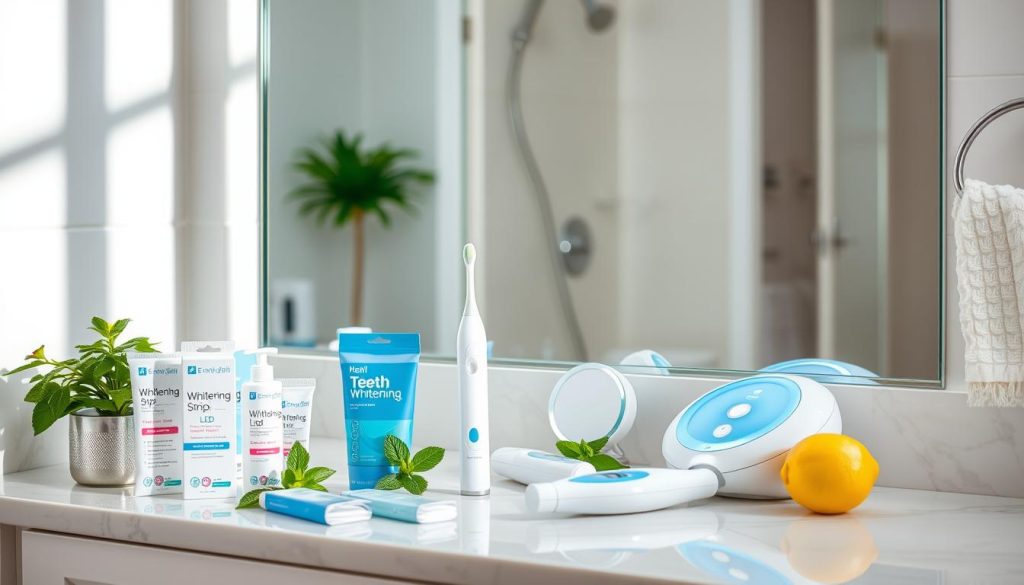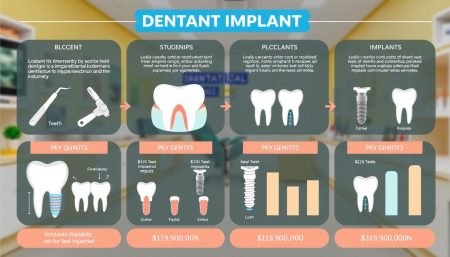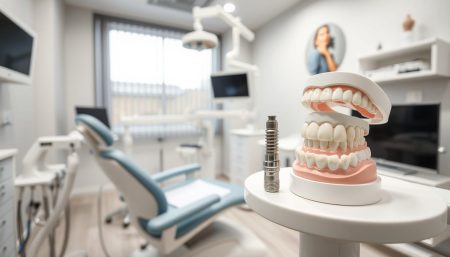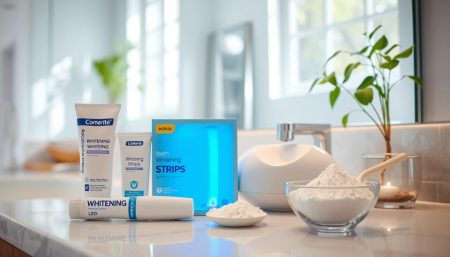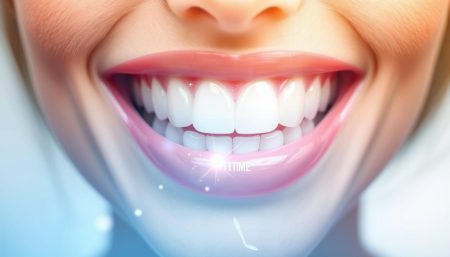People worldwide are looking for the best teeth whitening methods to brighten their smiles. With so many options, finding the right one can be tricky. This article will help you understand each method. It will guide you to choose a whitening solution that fits your lifestyle and budget.
Key Takeaways
- Discovering your ideal teeth whitening treatment based on personal needs and preferences.
- Understanding the pros and cons of professional teeth whitening compared to at-home alternatives.
- Exploring natural teeth whitening options for those preferring a more organic approach.
- Assessing the efficacy and safety of various whitening products to ensure healthy usage.
- Investigating long-term strategies to maintain the results of top teeth whitening solutions.
- Learning the impact of lifestyle choices on the longevity of whited teeth.
- Evaluating cosmetic dentistry as a permanent alternative to traditional teeth whitening.
Understanding Teeth Whitening and Its Benefits
Teeth whitening is a cosmetic process that makes teeth look better by removing stains. It aims to give you a radiant smile by using special bleaching agents. This makes your smile more attractive.
The benefits of teeth whitening go beyond looks. It boosts your self-esteem and makes you feel more confident. It can even remove stains from coffee, tea, red wine, and tobacco, which regular brushing can’t.
- Enhanced appearance and a more attractive smile
- Increased self-confidence with a brighter smile
- Effective removal of tough stains
Knowing these benefits helps you decide if teeth whitening is right for you. It’s not just about a brighter smile. It’s about feeling better about yourself every day.
Teeth whitening is not just about a cosmetic upgrade; it is about transforming how you feel about yourself every time you look in the mirror.
Professional Teeth Whitening
Are you thinking about getting your teeth professionally whitened? It’s important to know what it involves, the costs, and what others have said. Here’s a detailed look at professional whitening treatments to help you decide.
What to Expect from In-Office Whitening
Professional teeth whitening is a fast and effective way to brighten your smile. It uses a strong bleaching gel and a special light to whiten teeth quickly. Most people see big changes right after their first visit, making it a top choice for quick results.
Comparing Professional Services and Costs
| Service | Cost Range | Duration | Expected Whitening |
|---|---|---|---|
| Basic In-Office Whitening | $300 – $600 | 45-60 minutes | 3-8 shades lighter |
| Laser Teeth Whitening | $500 – $2500 | 30-60 minutes | 6-12 shades lighter |
| Take-Home Kits from Dentist | $250 – $400 | Varies | 3-6 shades lighter |
Teeth whitening costs can vary a lot. It depends on the treatment and who you go to. In-office whitening is pricier but gives faster and more dramatic results.
Teeth Whitening Reviews: Professional Treatments
Reviews of professional teeth whitening often talk about how well it works. People love the quick results and the confidence boost. But, some might experience sensitivity, which is usually temporary.
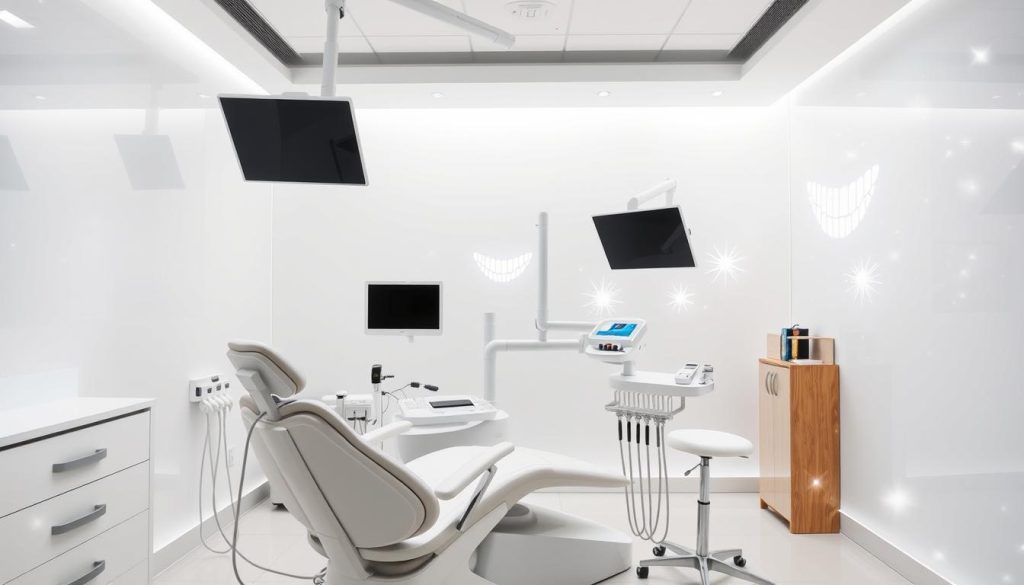
Choosing professional teeth whitening depends on what you want, your budget, and your preferences. Talking to a dentist can help you pick the best option for your needs and get the best results.
At-Home Teeth Whitening Kits
At-home teeth whitening kits are popular for their convenience and results. They let you brighten your smile without needing to visit the dentist often. We’ll look at how to pick the best kits, what’s in them, and show before and after photos.
Selecting the Best Teeth Whitening Kits
When picking teeth whitening kits, look at the whitening agent, how well the trays fit, and how easy they are to use. You can find everything from pre-filled trays to gels with LED lights. The goal is to find a kit that whitens well but doesn’t hurt your teeth.
Diving into Teeth Whitening Products Ingredients
Most kits use peroxide, like hydrogen or carbamide peroxide, to break stains. This makes your teeth look brighter. Some kits also have natural stuff like charcoal or coconut oil to help and protect your teeth.
Teeth Whitening Before and After: Real Results from Kits
To see how well kits work, look at teeth whitening before and after pictures. These pictures show what’s possible with different products. Here’s a table with some popular kits and what people say about them.
| Kit Name | Key Ingredients | Time Required for Results | User Satisfaction Rating |
|---|---|---|---|
| Illuminate Smile Kit | Hydrogen Peroxide, Peppermint Oil | 10 Days | 4.5/5 |
| Teeth Glow Advanced | Carbamide Peroxide, Aloe Vera | 15 Days | 4.2/5 |
| Sapphire Bright Express | Hydrogen Peroxide, Chamomile Extract | 7 Days | 4.8/5 |
Natural Teeth Whitening Remedies
Looking into natural teeth whitening remedies is a gentle and safe choice. Many people prefer these options because they are seen as safe and affordable.
It’s important to know which natural methods really work. We’ll look at some home-based ways to get a brighter smile without harsh chemicals.
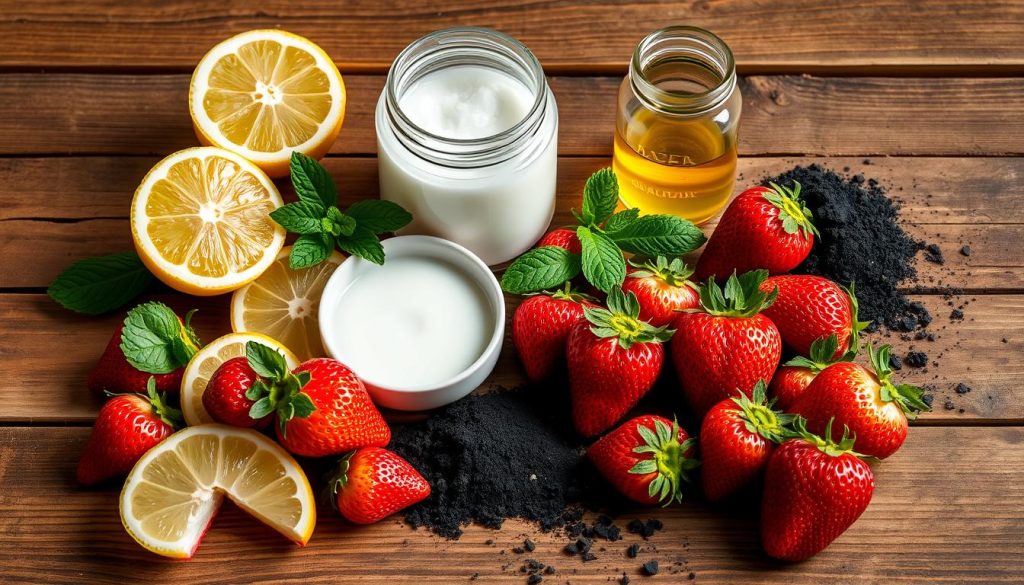
- Baking Soda: It’s gentle and can remove surface stains.
- Hydrogen Peroxide: Used as a natural bleach, it works well in diluted form.
- Coconut Oil: Oil pulling with coconut oil can reduce bacteria and whiten teeth.
- Apple Cider Vinegar: It can whiten teeth, but use it carefully to avoid damage.
- Fruits like Strawberries: Strawberries have malic acid that can brighten teeth, but results vary.
These natural teeth whitening remedies are less invasive. But, it’s important to have realistic expectations. Results might not be as strong as professional treatments.
| Remedy | Effectiveness | Usage Tips |
|---|---|---|
| Baking Soda | Medium | Use once a week as a toothpaste additive. |
| Hydrogen Peroxide | High | Dilute with water and use as a mouthwash. |
| Coconut Oil | Low to Medium | Swish in the mouth for 10-20 minutes daily. |
| Apple Cider Vinegar | Medium | Use sparingly, no more than once a week. |
| Strawberries | Low | Mash up and apply to teeth occasionally. |
Before trying any new treatment, even natural ones, talk to a dental professional. They can help you choose the safest and best option for your teeth.
What is the Best Teeth Whitening: Deciphering the Science
The search for the best teeth whitening leads us into the science behind teeth whitening. We’ll look at how science has shaped today’s teeth whitening. It makes these methods both effective and easy to use.
The Role of Peroxides in Whitening
Peroxides, like hydrogen peroxide and carbamide peroxide, are key in whitening teeth. They break down into oxygen radicals. These radicals go into the enamel and break the bonds that hold stains.
This process, called oxidation, makes teeth brighter and whiter.
How Light and Laser Work in Teeth Whitening
New technology has made teeth whitening faster with light and laser. These tools speed up the peroxide reaction. This means quicker and more noticeable results.
Light helps activate the peroxide faster. Laser whitening uses specific light to speed up the oxygen release. This makes the whitening process faster in a single session.
Knowing the science behind teeth whitening helps set realistic expectations. It also helps choose the right whitening option. Whether it’s an at-home kit or a professional service, understanding the science can lead to better results.
Maintaining Safety During Teeth Whitening
Teeth whitening is a popular choice, but safety is key. Knowing the teeth whitening side effects and how to minimize sensitivity is important. This section covers common concerns and how to keep your mouth healthy during whitening.
Understanding Teeth Whitening Side Effects
Teeth whitening can cause sensitivity or gum irritation. These issues are usually short-lived but can be uncomfortable. The main thing for teeth whitening safety is using products correctly and following treatment times.
Best Practices to Minimize Sensitivity
To avoid discomfort during and after whitening, follow these tips:
- Use toothpaste for sensitive teeth before and after treatment.
- Avoid foods and drinks with extreme temperatures right after whitening.
- Stick to the product instructions or your dentist’s advice to avoid overuse.
- If sensitivity lasts, try shorter treatments or lower-strength products.
| Method | Effectiveness | Sensitivity Potential | Safety Notes |
|---|---|---|---|
| Professional Whitening | High | Moderate | Performed under controlled conditions |
| At-home Trays | Moderate to High | Moderate to High | Requires diligent follow-up care |
| Whitening Strips | Moderate | Low to Moderate | Lower concentration of active ingredients |
| Natural Remedies | Variable | Low | Least likely to cause sensitivity but results can vary greatly |
Choosing the right method and taking care of your mouth is key for teeth whitening safety. By knowing the teeth whitening side effects and how to minimize sensitivity, you can get the results you want without harming your health.
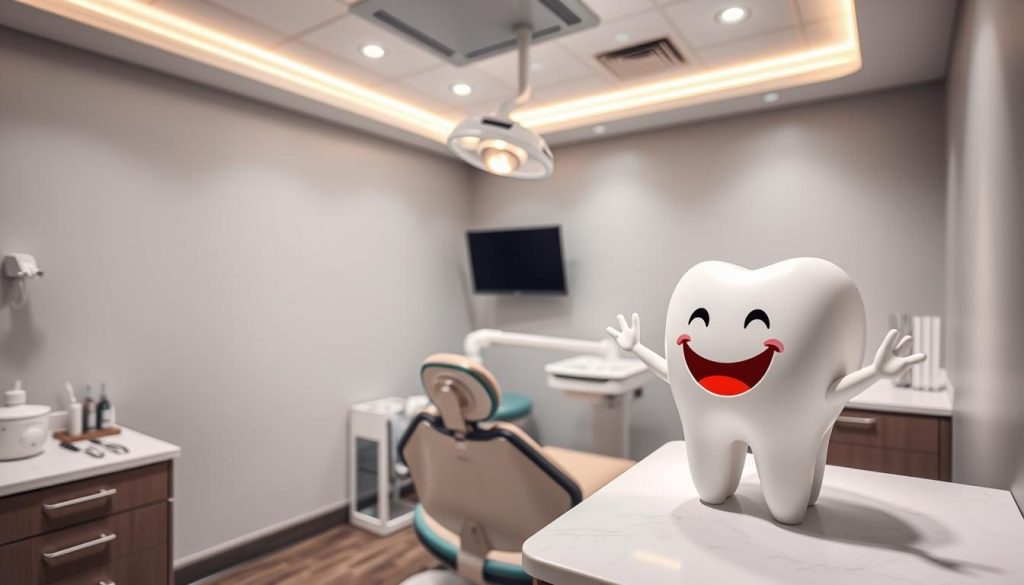
Lifestyle Factors Affecting Whitening Longevity
Keeping your smile bright after teeth whitening is more than just the treatment. Many daily habits and choices affect how long your teeth stay white. We’ll look at how your daily life can impact your whitening results.
What you eat matters a lot. Drinks like coffee, tea, and red wine can stain your teeth if you drink them often. Acidic foods, like citrus fruits, can also wear away your enamel, making your teeth look dull.
Smoking is another big factor. It contains tar and nicotine, which stain teeth. These stains are hard to get rid of and can make your teeth look brown or yellow.
How you take care of your teeth is also key. Brushing, flossing, and using mouthwash regularly helps keep your teeth clean and white. It stops plaque and stains from building up.
| Lifestyle Factor | Impact on Whitening Longevity |
|---|---|
| Dietary Choices (Coffee, Tea, Red Wine) | Negative – Promotes Staining |
| Smoking | Negative – Causes Deep Stains |
| Oral Hygiene Practices | Positive – Helps Maintain Whiteness |
To keep your teeth white longer, make some lifestyle changes. Cut down on foods and drinks that stain, quit smoking, and take better care of your teeth. These steps will help your teeth stay white and healthy for longer.
Teeth Whitening Solutions for Sensitive Teeth
Looking for teeth whitening for sensitive teeth can be tough. But, the right sensitive teeth solutions can make it painless. This part will look at products and methods for those with sensitive teeth.
Products with lower hydrogen peroxide are key for sensitive teeth.
Non-peroxide formulas, like sodium bicarbonate or activated charcoal, are gentler.
Using desensitizers before whitening can protect your teeth’s nerves.
Many products are out there, but some are better for sensitive teeth.
| Brand | Type | Active Ingredients | User Feedback |
|---|---|---|---|
| Brand A | Whitening Strips | Low-dose Hydrogen Peroxide | Positive, with reduced sensitivity |
| Brand B | Whitening Gel with Tray | Sodium Bicarbonate | High user satisfaction, no discomfort |
| Brand C | Whitening Toothpaste | Activated Charcoal | Good for daily use, mild bleaching properties |
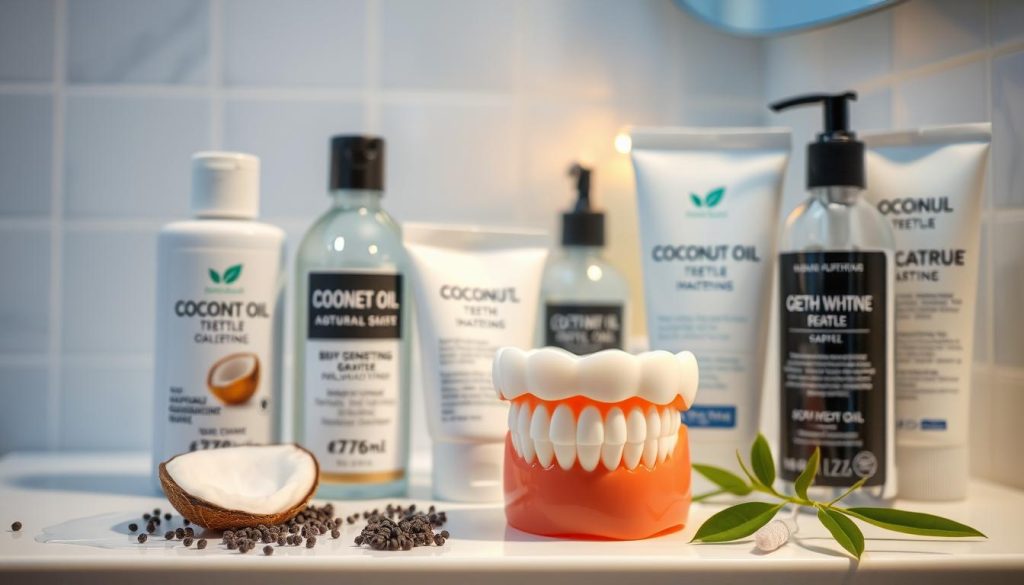
Choosing the right whitening products is important. But, using fluoride treatments can also help. They strengthen the enamel and lessen sensitivity after whitening.
For teeth whitening for sensitive teeth, talking to a dentist is best. They can create a plan that fits your needs. This way, you get results safely and comfortably.
Utilizing Whitening Toothpastes: Do They Work?
Whitening toothpastes are a top pick for a brighter smile. They are easy to use and work well. The secret is in their ingredients in whitening toothpastes, which aim to remove stains and brighten enamel.
Analyzing Ingredients in Whitening Toothpastes
The success of whitening toothpastes comes from their active ingredients. Hydrogen peroxide and baking soda are common. They bleach and scrub away stains, respectively.
| Ingredient | Function | Whitening Effect |
|---|---|---|
| Hydrogen Peroxide | Bleaching agent that lightens tooth color | High |
| Baking Soda | Abrasive that removes surface stains | Moderate |
| Fluoride | Strengthens enamel and prevents decay | Additional Benefit |
| Activated Charcoal | Absorbs plaque and microscopic particles | Moderate |
How to Integrate Whitening Toothpastes in Daily Routines
To get the most from whitening toothpastes, use them every day. Add them to your morning and night brushing. Here’s how to do it right:
- Pick a toothpaste with the right amount of ingredients in whitening toothpastes.
- Brush softly to protect your enamel, especially with baking soda.
- Think about adding mouthwash or whitening strips for extra whitening.
Whitening toothpastes work well for surface stains. But for deeper stains, you might need a dentist. Knowing how to use ingredients in whitening toothpastes helps you get a brighter smile.
Over-The-Counter Whitening Strips and Gels
The world of at-home teeth whitening has changed with whitening strips and whitening gels. These products are easy to use and affordable. They help brighten your smile without a dentist’s help.
Whitening strips are thin, flexible, and coated with a bleaching gel. They stick to your teeth and stay on for 5 to 30 minutes. Whitening gels are brushed onto your teeth or used in a mouth tray. This keeps the gel in contact with your teeth for a set time.
- Accessibility: You can find whitening strips and whitening gels at many stores and online.
- Cost-Effective: They’re cheaper than professional whitening, making them a good choice for those on a budget.
- Convenience: You can use them at home, whenever you want, for a flexible whitening routine.
The results from using whitening strips and whitening gels can differ. This depends on your teeth’s color, the product’s strength, and how often you use it.
| Product Type | Application Time | Expected Results |
|---|---|---|
| Whitening Strips | 5-30 minutes | Lighten by several shades over weeks |
| Whitening Gels | 30 minutes to 2 hours | Varies, more gradual whitening |
In summary, whitening strips and whitening gels are good options for whitening your teeth at home. Always follow the instructions and talk to a dentist for the best results and to avoid problems like gum irritation or tooth sensitivity.
Custom Whitening Trays: Personalized Approach to Whitening
Personalized teeth whitening solutions like custom whitening trays are a great mix of effectiveness and convenience. They fit your teeth perfectly, making sure every part gets the whitening treatment it needs. This method can lead to better whitening results and less gum irritation and sensitivity than generic products.
The Process of Getting Custom Trays
To start your journey to a brighter smile, visit a dental professional. They will take precise impressions of your teeth. These impressions are then used to make your custom trays in a dental lab. The accuracy of these trays is key to ensure the whitening gel is evenly distributed.
Why Custom Trays May Be the Best Investment
Custom whitening trays might seem pricier than over-the-counter options at first. But, the long-term benefits and effectiveness of custom whitening trays make them a smart choice. They fit your teeth perfectly, leading to better whitening results. Plus, you can use them over and over again, saving money in the long run.
Using custom trays also means less chance of sensitivity and irritation. This personal touch not only boosts your oral health but also encourages consistent use. This leads to better whitening results overall.
In summary, while they might cost more initially, custom trays offer long-term value. Their personalized fit, safety, and ability to be reused make them a practical and smart choice for whitening and maintaining your oral health.
Impact of Diet and Oral Hygiene on Teeth Whitening
Many people want a bright, white smile. But, they often overlook the importance of diet and teeth whitening habits. Keeping up with good oral hygiene is also key to keeping your teeth white.
Foods and Drinks to Avoid for Whiter Teeth
Some foods can stain your teeth or make them darker. To keep your smile bright, try to eat less of these:
- Coffee and black teas
- Red wine
- Colored sodas
- Dark juices like grape and cranberry
- Soy sauce and balsamic vinegar
- Highly pigmented fruits such as blueberries and pomegranates
It’s not just about avoiding stains. It’s about living a healthy lifestyle that helps your teeth stay white.
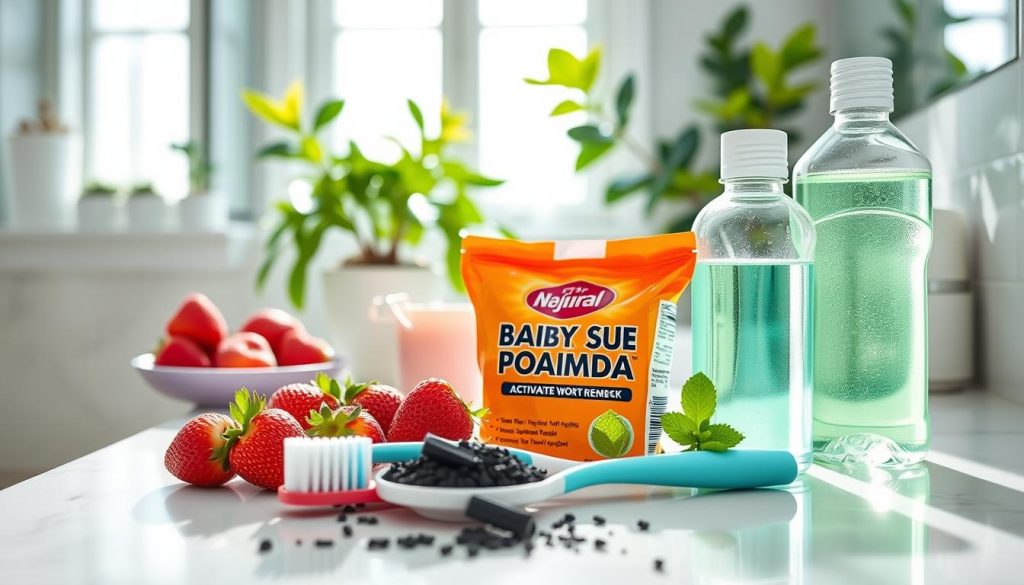
Best Practices in Oral Hygiene for Lasting Whiteness
Good oral hygiene is key to keeping your teeth white. You need to brush and floss regularly. Here are some tips:
| Oral Hygiene Practice | Benefits |
|---|---|
| Regular brushing with fluoride toothpaste | Removes stains and prevents decay |
| Flossing daily | Eliminates plaque build-up between teeth |
| Using mouthwash | Brightens teeth and freshens breath |
| Regular dental check-ups | Professional cleaning and early problem detection |
Following these oral hygiene tips is crucial for your teeth and overall health. It’s not just about looks. It’s about keeping your teeth and mouth healthy.
Cosmetic Dentistry: Alternatives to Traditional Whitening
Looking for something more than just teeth whitening? Cosmetic dentistry has got you covered with dental veneers and bonding. These options not only make your smile look better but also last longer. They even protect against stains that regular whitening can’t handle. Let’s dive into why these are great alternatives.
Veneers and Bonding as Whitening Alternatives
Dental veneers are thin, custom-made shells for your teeth. They change the color, shape, size, or length of your teeth. Made from porcelain or resin, veneers give a permanent white smile without needing constant touch-ups. Bonding, meanwhile, uses a tooth-colored resin to fix teeth. It’s shaped, hardened, and polished to blend in with your other teeth.
Both veneers and bonding hide stains and fix chips or gaps. They’re great for a brighter smile.
Evaluating Long-Term Results and Costs
Thinking about cosmetic dentistry? It’s important to consider both the long-term benefits and the upfront cost. Veneers and bonding last a long time and don’t easily stain. They’re perfect for those wanting a lasting, white smile.
| Treatment | Expected Lifespan | Approximate Cost | Maintenance Required |
|---|---|---|---|
| Veneers | 10-15 years | $925 – $2,500 per tooth | Regular dental check-ups |
| Bonding | 4-8 years | $300 – $600 per tooth | Annual polishing |
Choosing between veneers, bonding, or other cosmetic dentistry depends on your needs and budget. Talking to a dentist can help find the best fit for you.
Conclusion
We’ve looked at many ways to whiten teeth, from professional treatments to home kits and natural methods. Each option is tailored to fit different needs and lifestyles. The key is to find what works best for you, considering your budget and dental health.
From strong peroxide formulas to gentle toothpastes, the goal is clear: to keep your teeth white. This means making smart food choices, brushing well, and understanding how whitening works. Knowing the science helps you make choices that last.
As we wrap up, remember the lasting beauty of a bright smile. Choosing the right teeth whitening is more than looks; it boosts confidence and happiness. May your chosen method lead to the smile you dream of, shining brightly for years.
FAQ
Q: What are the best teeth whitening methods available?
A: The top teeth whitening methods include professional treatments, at-home kits, and natural remedies. You can also try over-the-counter strips, gels, and toothpastes. The best choice for you depends on your budget, preferences, and teeth condition.
Q: What is teeth whitening and how does it benefit me?
A: Teeth whitening removes stains from your enamel, making your smile brighter. It boosts your confidence and removes deep stains.
Q: How much does professional teeth whitening cost?
A: Professional teeth whitening costs vary by location, treatment, and dentist fees. Prices range from a few hundred to over a thousand dollars.
Q: Are teeth whitening kits safe to use at home?
A: Most at-home kits are safe if used as directed. Always follow the instructions and watch for any sensitivity or allergies.
Q: Can natural teeth whitening remedies effectively brighten my smile?
A: Natural remedies can mildly whiten your teeth. Ingredients like baking soda and hydrogen peroxide can remove stains. But, they’re not as strong as professional solutions.
Q: How does peroxide in teeth whitening products lead to a whiter smile?
A: Peroxide in whitening products breaks down stains on your enamel. This chemical reaction makes your teeth whiter.
Q: What are the potential side effects of teeth whitening?
A: Teeth whitening can cause sensitivity and gum irritation. These symptoms are usually temporary. Following the product’s instructions can help avoid discomfort.
Q: How can I maintain the results of teeth whitening?
A: To keep your teeth white, avoid stain-causing foods and drinks. Quit smoking and brush regularly. You might need touch-up treatments over time.
Q: Are whitening treatments suitable for people with sensitive teeth?
A: Yes, there are treatments for sensitive teeth. They use lower bleaching agents or are less irritating. Always talk to a dentist before starting if you’re sensitive.
Q: How effective are whitening toothpastes and how should they be used?
A: Whitening toothpastes remove surface stains with mild abrasives and chemicals. They’re good for daily use but not as strong for deep stains.
Q: What’s the difference between whitening strips and gels?
A: Whitening strips are thin, flexible, and coated with gel. Gels are applied with trays or a brush. Both use peroxide but differ in application.
Q: How do custom whitening trays compare to over-the-counter options?
A: Custom trays fit your teeth perfectly, offering better results than generic options. They’re pricier but more effective and personalized.
Q: How does diet affect teeth whitening results?
A: Your diet can affect how long your whitening lasts. Stain-causing foods like coffee and red wine can dull your smile. Eating less of these can help keep your teeth white.
Q: What are alternatives to traditional teeth whitening methods?
A: Besides whitening, you can try dental veneers or bonding. These can make your teeth look whiter and address other issues like gaps.












